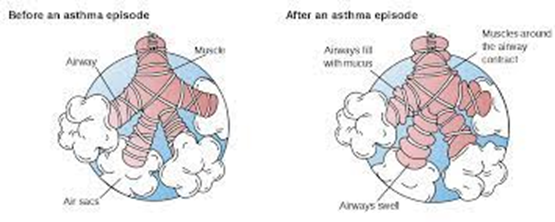A nurse is caring for a client who has a spinal cord injury at the first thoracic level. Which of the following should the nurse recognize can trigger autonomic dysreflexia?
(Select All that Apply.)
Sexual intercourse
Tight clothing
Nausea
Surgery below level of injury
Urinary tract infections
Correct Answer : A,B,D,E
Choice A Reason:
Sexual intercourse is correct. Stimulation of the genitalia or other areas below the level of injury can trigger autonomic dysreflexia in individuals with spinal cord injuries.
Choice B Reason:
Tight clothing is correct. Any form of tight or restrictive clothing, including belts or waistbands, can stimulate the body below the level of injury and trigger autonomic dysreflexia.
Choice C Reason:
Nausea is incorrect. While nausea itself is not a common trigger for autonomic dysreflexia, it may occur as a result of the condition. Autonomic dysreflexia can cause a variety of symptoms, including nausea, due to the sudden increase in blood pressure.
Choice D Reason:
Surgery below the level of injury is correct. Surgical procedures performed below the level of the spinal cord injury can lead to stimulation of the body below the injury site, triggering autonomic dysreflexia.
Choice E Reason:
Urinary tract infections (UTIs) is correct. Infections of the urinary tract, especially those involving the bladder or urethra, can stimulate the body below the level of injury, leading to autonomic dysreflexia.
Nursing Test Bank
Naxlex Comprehensive Predictor Exams
Related Questions
Correct Answer is C
Explanation
Choice A Reason:
Decreased mucus production contributes to airway constriction: This statement is incorrect. Bronchospasm does not decrease mucus production; instead, it primarily affects the smooth muscles surrounding the bronchioles, leading to their constriction and narrowing of the airways. Increased mucus production, often accompanied by inflammation, can contribute to airway obstruction in conditions like asthma.
Choice B Reason:
Inflammation is reduced due to airway diameter: This statement is incorrect. Bronchospasm typically occurs in the setting of inflammation in conditions such as asthma. Constriction of the airways during bronchospasm exacerbates the inflammation and can further narrow the airways, leading to symptoms such as wheezing and dyspnea.
Choice C Reason:
Bronchospasm occurs when there is inflammation, edema, and excess mucus: This statement is partially correct. Bronchospasm often occurs in the presence of inflammation, edema, and excess mucus production, as seen in conditions like asthma. These factors contribute to airway hyperresponsiveness, leading to bronchospasm and airway narrowing.
Choice D Reason:
Airway obstruction occurs due to thinning mucus: This statement is incorrect. Airway obstruction in conditions like asthma is primarily due to bronchospasm, inflammation, and excessive mucus production, rather than thinning mucus. Thinning of mucus would not typically contribute to airway obstruction.

Correct Answer is ["B","D","E","F"]
Explanation
Choice A Reason:
Sedatives do not impact the risk of obstructive sleep apnea: This statement is incorrect. Sedatives, particularly those that cause muscle relaxation or depress the central nervous system, can exacerbate obstructive sleep apnea by further relaxing the muscles of the upper airway, leading to increased airway collapse during sleep.
Choice B Reason:
CPAP compliance enhances quality of sleep is correct. Continuous positive airway pressure (CPAP) therapy is a common treatment for obstructive sleep apnea. Compliance with CPAP therapy, meaning consistent and proper use of the CPAP device during sleep, is essential for effectively managing sleep apnea and improving sleep quality.
Choice C Reason:
Alcohol does not affect the risk of obstructive sleep apnea. This statement is incorrect. Alcohol consumption can worsen obstructive sleep apnea by promoting muscle relaxation in the upper airway, leading to increased airway collapse and more frequent episodes of apnea during sleep.
Choice D Reason:
Obesity increases the risk of obstructive sleep apnea. This statement is correct. Obesity is a significant risk factor for obstructive sleep apnea. Excess fat tissue around the neck can increase the likelihood of airway obstruction during sleep, contributing to the development or worsening of sleep apnea.
Choice E Reason:
Positional therapy enhances client comfort is correct. Positional therapy involves strategies to encourage sleeping in positions that minimize the severity of obstructive sleep apnea, particularly for individuals with positional OSA (where apnea events are primarily or significantly worse when sleeping in specific positions, such as supine). This statement is correct.
Choice F Reason:
Smoking increases the risk of obstructive sleep apnea: This statement is correct. Smoking can increase the risk of obstructive sleep apnea due to its effects on upper airway inflammation and respiratory function. Smoking cessation can be beneficial in managing sleep apnea and improving overall health.
Whether you are a student looking to ace your exams or a practicing nurse seeking to enhance your expertise , our nursing education contents will empower you with the confidence and competence to make a difference in the lives of patients and become a respected leader in the healthcare field.
Visit Naxlex, invest in your future and unlock endless possibilities with our unparalleled nursing education contents today
Report Wrong Answer on the Current Question
Do you disagree with the answer? If yes, what is your expected answer? Explain.
Kindly be descriptive with the issue you are facing.
